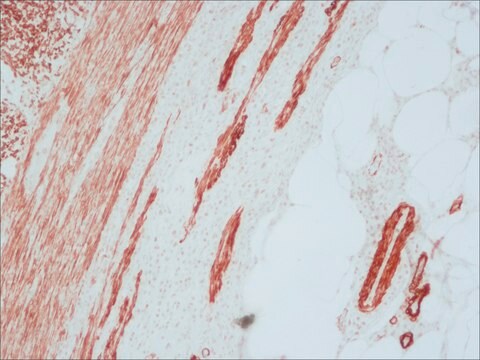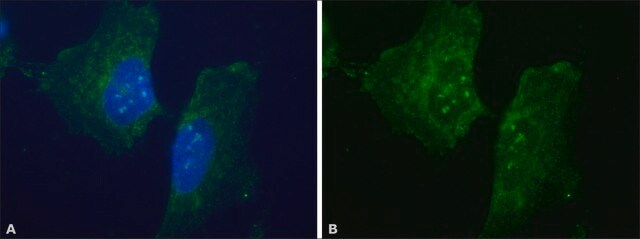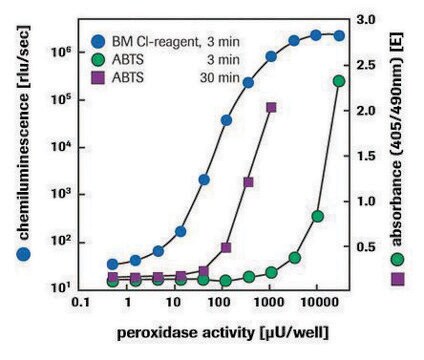07-419
Anti-SHP-1/SHPTP-1 Antibody
Upstate®, from rabbit
Synonym(s):
Anti-DRPLA
Sign Into View Organizational & Contract Pricing
All Photos(1)
About This Item
UNSPSC Code:
12352203
eCl@ss:
32160702
NACRES:
NA.41
Recommended Products
biological source
rabbit
Quality Level
antibody form
purified immunoglobulin
antibody product type
primary antibodies
clone
polyclonal
species reactivity
human
manufacturer/tradename
Upstate®
technique(s)
immunoprecipitation (IP): suitable
western blot: suitable
isotype
IgG
NCBI accession no.
UniProt accession no.
shipped in
wet ice
target post-translational modification
unmodified
Specificity
SHP1
Immunogen
Full-length glutathione transferase SHP-1 fusion protein, purified from bacteria
Application
Research Category
Signaling
Signaling
Research Sub Category
Cytoskeletal Signaling
Cytoskeletal Signaling
This Anti-SHP-1/SHPTP-1 Antibody is validated for use in IP, WB for the detection of SHP-1/SHPTP-1.
Quality
routinely evaluated by immunoblot in RIPA lysates from human A431 carcinoma cells
Target description
65kDa
Physical form
0.1M Tris-glycine, pH 7.4, 0.15M NaCl, 0.05% sodium azide
Format: Purified
Protein A purified
Storage and Stability
1 year at 2-8°C
Analysis Note
Control
Positive Antigen Control: Catalog #12-301, non-stimulated A431 cell lysate. Add 2.5µL of 2-mercaptoethanol/100µL of lysate and boil for 5 minutes to reduce the preparation. Load 20µg of reduced lysate per lane for mingels.
Positive Antigen Control: Catalog #12-301, non-stimulated A431 cell lysate. Add 2.5µL of 2-mercaptoethanol/100µL of lysate and boil for 5 minutes to reduce the preparation. Load 20µg of reduced lysate per lane for mingels.
Legal Information
UPSTATE is a registered trademark of Merck KGaA, Darmstadt, Germany
Disclaimer
Unless otherwise stated in our catalog or other company documentation accompanying the product(s), our products are intended for research use only and are not to be used for any other purpose, which includes but is not limited to, unauthorized commercial uses, in vitro diagnostic uses, ex vivo or in vivo therapeutic uses or any type of consumption or application to humans or animals.
Not finding the right product?
Try our Product Selector Tool.
Storage Class Code
10 - Combustible liquids
WGK
WGK 1
Certificates of Analysis (COA)
Search for Certificates of Analysis (COA) by entering the products Lot/Batch Number. Lot and Batch Numbers can be found on a product’s label following the words ‘Lot’ or ‘Batch’.
Already Own This Product?
Find documentation for the products that you have recently purchased in the Document Library.
Erythropoietin induces sustained phosphorylation of STAT5 in primitive but not definitive erythrocytes generated from mouse embryonic stem cells.
Kazue Tsuji-Takayama, Takeshi Otani, Toshiya Inoue, Shuji Nakamura, Ryuichi Motoda et al.
Experimental Hematology null
J Yamamoto et al.
British journal of cancer, 110(9), 2232-2245 (2014-04-20)
Malignant pleural mesothelioma (MPM) is an aggressive neoplasm arising from mesothelial lining of pleura. CD26 molecules preferentially expressed on epithelioid type of MPM. This study investigates the molecular mechanisms of CD26 regulating MPM cells in vitro and in vivo. Biochemical
P Bruhns et al.
The Journal of biological chemistry, 275(48), 37357-37364 (2000-10-04)
FcgammaRIIB are single-chain low affinity receptors for IgG that negatively regulate immunoreceptor tyrosine-based activation motif-dependent cell activation. They bear one immunoreceptor tyrosine-based inhibition motif (ITIM) that becomes tyrosyl-phosphorylated upon coaggregation of FcgammaRIIB with immunoreceptor tyrosine-based activation motif-bearing receptors and that
Thierry Voisin et al.
FASEB journal : official publication of the Federation of American Societies for Experimental Biology, 22(6), 1993-2002 (2008-01-17)
Orexins acting at the G protein-coupled receptor (GPCR) OX1R have recently been shown to promote dramatic apoptosis in cancer cells. We report here that orexin-induced apoptosis is driven by an immunoreceptor tyrosine-based inhibitory motif (ITIM) (IIY(358)NFL) present in the OX1R.
N Rivard et al.
The Journal of biological chemistry, 270(18), 11017-11024 (1995-05-05)
PTP1C and PTP1D are non-transmembrane protein-tyrosine phosphatases (PTPs), which contain two src homology-2 domains. These enzymes are believed to play a role in regulating downstream signaling from receptors with intrinsic tyrosine kinase activity. The present study describes the tyrosine phosphorylation
Our team of scientists has experience in all areas of research including Life Science, Material Science, Chemical Synthesis, Chromatography, Analytical and many others.
Contact Technical Service





